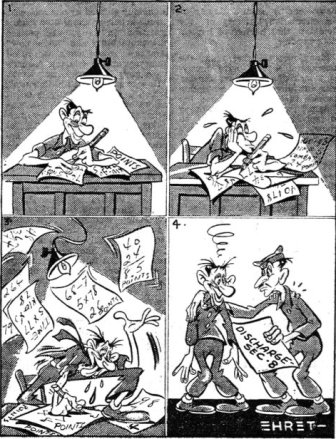|
Dr. Emeline Hayward, secretary of the society, said of pinups, "If one can't touch, feel, or kiss - looking is good. If one can do so - looking isn't good." |
|
Logan's book, Democracy Needs The Negro, deals with the problems of the Negro as a minority group. It will be published in September by MacMillan and Company. Logan, a member of the National Association for the Advancement of Colored People, attended Luther University in New Jersey. |

Vol. III No. 35 Delhi, Thursday, May 10, 1945 Reg. No. L5015

|

A Late Photo |
German Doctor
Can Recognize
Hitler's Body
The U.S., in the voice of President Truman, is officially convinced that Adolf Hitler is dead.
Soviet Russia issued an official communiqu stating that Hitler, Propaganda Minister Joseph Goebles, and German Chief of Staff Krebs has all committed suicide in Berlin. But the realistic Russians continued digging in the ruins of the Reich Chancellery for the corpses.
Truman stated he was convinced of Hitler's demise. He said he based his belief on the best authority but did not identify his source. Asked by reporters if he meant that Hitler was officially dead, Truman replied, "Yes."
SOVIETS SAY SUICIDE
So in the eyes of the U.S. and the Soviet Union the Nazi dictator is gone forever. Army News Service carried no official comment from Great Britain.
The Soviets say he committed suicide. The U.S. has given out no statement on how he died. Heinrich Himmler, engaged in surrender negotiations with the Allies, reportedly stated that Hitler was suffering from cerebral hemorrhage and could not live more than 48 hours.
The Himmler statement was issued several days before the Nazis said he had been killed in defense of Berlin and announced Adm. Karl Doenitz as his successor.
IDENTIFICATION
Meanwhile, in the U.S., the former chief legal adviser to the pre-Hitler German police, one Dr. Robert Kempner, revealed the Nazi leader had certain physical characteristics which would establish his identity.
Kempner, now a U.S. citizen, said he had studied Hitler's characteristics while investigating Der Fuehrer after his arrest in the abortive beer hall putsch.
Kempner described Hitler as having the following characteristics: abnormally long right thumb, right ear more pointed that his left, stooped shoulders which would be revealed by the bone condition.
He stated that a complete identification file, including fingerprints, was kept on Hitler in the Landsberg Fortress in Bavaria during his imprisonment there in 1924. The fortress was recently seized by American troops. He said he had turned over to Federal authorities the name of a Berlin physician who could make positive identification of the body.
|
LONGEST LINE
IN THE WORLD
The longest pipeline in the world is now in operation from Calcutta to China, it was announced in a joint statement this week by Maj. Gens. W. E. R. Covell and Gilbert X. Cheves, heads of SOS in the India-Burma and China Theaters respectively.
Gasoline is now being carried through the pipeline, which starts in Calcutta, runs the length of the Brahmaputra Valley to Assam, crosses the Patkai Mountain range to Burma thence over the Hump into China.
Trucks convoying the precious cargoes of war to embattled China are being fed with gasoline and oil from this pipeline. Shipping space on the U.S.-operated Bengal-Assam railroad no longer has to be utilized for fuel. Similarly, cargo space over The Hump can be diverted to other military uses because of the fuel line.
SERVICES B-29'S
Summed up, it is a great step forward in the primary mission of the India-Burma Theater, funneling supplies through to China. Even before it was extended to China, it was literally worth its weight in gasoline. For months the pipeline has been serving B-29 Superfortress bases in India and other airfields in Assam, from where supplies are ferried over The Hump.
The story of the planning is a gasoline-throbbing tribute to the far-sighted strategic planning of the brass, to the hardihood and toil of the SOS forces, who once again have made scoffers swallow the word "impossible."
COVELL SUPERVISION
The construction was under the supervision of Covell. Under his command he had such men as Maj. Gen. Lewis A. Pick of Ledo Road fame, Brig. Gen. Thomas F. Farrell, former chief engineer of New York State, Col. A. C. Welling of Alcan Highway reputation, and Col. William C. Kinsolving, former general manager of the Sun Pipeline Company.
Farrell was in charge of the initiation of the pipeline construction. When he returned to the States, Welling took over. Kinsolving was in charge of building the line from Calcutta to Assam, while Pick handled construction of the final section. Directly under Pick, with responsibility for the section which goes through Burma and into China, was Lt. Col. Birney K. Morse, formerly chief engineer of the Susquehanna Pipeline Company.
PIPELINE COMPANIES
So much for the quarterbacks of the Covell Construction team. But the men who carried out the bitter, unrelenting work of laying the line across almost impassable terrain, drenched by the monsoon and harassed by Japs were the officers and G.I.'s of the Engineer Petroleum Distribution Companies.
The Petroleum fatigue-clads laid all of the line except the first 50 miles. The initial part was undertaken by Engineer General Service troops, since there were no specialists available when the go-ahead signal was given.
Pipe, personnel and supplies were transported by railroads, barge lines, river boats, and makeshift rafts in the continuation of the matter-of-fact miracles that have characterized the Transportation Corps in this Theater. When weather broke down these facilities, the Air Corps wallahs took over transportation.
|
Signal Corps construction crews built pole lines parallel to the pipeline, sharing the hardships and dangers of the Petroleum crews. The communication lines enabled the Engineers to maintain contact with the pumping stations along the route to the rear. Without these Signal facilities, operation of the pipeline and control of the valuable cargo would have been impossible.
To cite one example of the difficulty of the work, there was one section in Burma which extended to the Shweli River Valley. In this area the Stilwell Highway enters mountains ranging over 5,000 feet. There was a junction road with the Burma Road, but it was so twisting and crooked, with such steep grades and narrow curves, that paralleling it with the pipeline was almost an impossibility.
While the road companies improved the existing lane, Pipeline Engineers decided to put the line over the mountains by the shortest possible route. To do this they left the main road and built one of the most unusual \access roads in the I-B Theater.
One crew took a bulldozer and started working north, while another crew started south, blasting huge rocks from the right of way and installing bridges and culverts at the numerous mountain seeps and streams. When the bulldozer completed its work in the north, it was rushed to the south and soon the new road was completed. Off this access road the pipeline reaches its highest elevation in the Theater, 4,960 feet.
Roundup quotes from the words of Rep. Mike Mansfield (R-Mont.) in a tribute made in the U.S. Congress to the men who built the pipeline:
"The vital urgency of the job was felt by all who worked day and night under protection of sentries throughout the monsoon when floods exceeded the protection of gum boots, and with malaria causing havoc among personnel.
"The work progressed among wild animals and snakes, many of which were killed while leeches, unwelcome but tenacious companions, not to mention other crawlers of the jungle, were a pest."
The Congressman told the story of the pipeline in one sentence, "At some stages obstacles appeared insuperable, but were overcome one by one."
First Soldier Returns
Home Under New Plan
Pfc. Armand Spinelli, former member of Merrill's Marauders, became the first of 6,000 soldiers this week to be returned immediately to the United States under the India-Burma Theater Temporary Plan as set forth in Theater Circulars No. 40 and 41.
A tommygunner during the North Burma Campaign, climaxed by the capture of Myitkyina, Spinelli left for his home, Erie, Pa., less than three hours after movements under the plan were put into effect by Theater Headquarters.
Remainder of the first group of soldiers to be returned to the U.S. under the Temporary Plan are already moving from their units. As many as may be accommodated will be transported by air.
The speed with which the first contingent is clearing the Theater is the result of careful planning, directed by lt. Gen. Dan I. Sultan.
When the War Department Readjustment Regulations reached Delhi, the Theater Commander directed all units to select and prepare for travel those men most deserving on the basis of total service since Sept. 16, 1940, length of service overseas, combat participation and wards, number of dependent children, and distressing home conditions.
Spinelli had spent only three months in the States since 1939 and participated in three major battles and 16 minor engagements.
Stimson Hails Rangoon Fall
Roundup Staff Article
Rangoon, capital and largest seaport of Burma, and terminus of the Burma Road, is now in British hands following evacuation of the city by the Japanese last week.
Secretary of War Henry L. Stimson hailed the seizure of Rangoon as opening "the old and eastern route for supplies to China." Stimson stated communication through the valleys of Burma will now be in "our control."
The British landed paratroops and sent troops ashore from a convoy escorted by strong elements of the East India Fleet. Some initial opposition was encountered but there was no fighting on the entrance to the city or within its confines.
In the meantime, 14th Army troops had captured the former Jap bases at Prome, Pegu, and Pyawbwe. An Indian Army observer stated that the Japs now have only a toehold left in the southeast.
The winning of Rangoon opens the port under which the first American good were shipped to besieged China over the Burma Road, which winds from the city up through Kunming, China.
With the cleaning up of the area south of Rangoon, most of it is now in the hands of the 14th Army, the Burma Road will be available, once it has been repaired for renewed convoys to China.
British reports are optimistic about the port installations and dock areas.
TELL OF RIGOROUS IMPRISONMENT
CALCUTTA - Happiest group of American soldiers in the India-Burma Theater this week were 73 prisoners of war liberated by the British 14th Army near Pegu on their drive to Rangoon.
The first group of recaptured American prisoners, mostly Air Corps personnel, was recuperating in 142nd General Hospital in Calcutta - with American beer, cigarettes, good food, candy bars, fruit juice, newspapers, magazines and everything possible that Army authorities and the Red Cross could provide for their comfort.
|
Behind them was a grim memory of starvation, filth, disease and indignities administered by the Japanese to the "special treatment" group composed of flyers captured after the bombing of the Japanese homeland began.
FORCED MARCH
The rescued men will also never forget the forced march out of their prison stronghold in Rangoon to north of Pegu where their Japanese guards deserted in the face of bullets and sound of artillery of the advancing 14th Army.
Two airmen, Lt. Kenneth F. Horner, New Orleans, and Pfc. Smith W. Radcliff, Dexter, Kans., had been prisoners for nearly 35 months; many others had sweated out their return since the fall of '43 and only two of the recaptured prisoners had been missing since this year.
Lt. Billy T. Davis, Los Angeles, a member of the "special treatment group," said the men were told they were put in this group because of "indiscriminate bombing of women and children, and of making war on the Burmese."
BEATEN WITH CLUBS
"Last New Year's the Japanese lined up the prisoners, and the Japs beat us with clubs made like pick handles," Davis recounted.
"I was beaten because I wasn't standing at attention properly when the guard came to the cell door to bring food. The beatings weren't so bad when the Japs were sober, but when they were drunk, it was hell," Davis said.
He told of a malaria stricken British pilot, who was beaten by two guards until insensible because they said he was faking. The Japs treated the Americans worse, according to Davis. He was in a cell with an Australian and a New Zealander, and after questioning as to nationality, he was always beaten the hardest.
"The beatings usually came when the Japs suffered a reverse. We knew when we were winning," said Davis. "I was slapped about four times a week, and it got so that I only hoped it wouldn't hurt too bad. You forget about the humiliation," Davis told reporters.
SEPARATE COMPOUND
The Westerners, Chinese and Indians were kept in separate compounds, and the Japs treated the Indians better because of political reasons, he said. The Indians were good to us, smuggling food and cigarettes which really helped, Davis reported.
He told of one British corporal, working in the commissary, who would steal stores to help feed his fellow prisoners. The Japs gave him terrific beatings several times when they caught him, but he kept right on, said Davis.
Most of the prisoners looked fairly healthy and expected to be on their way to Shangri-La soon. Lt. Col. Douglas G. Gilbert, Arlington, Va., a liaison officer with a Chinese army in the North Burma campaign when he was captured in 1943, attributed this to "better food during the past four months."
TREATMENT IMPROVING
Both Gilbert and Davis agreed that the Japanese treatment of prisoners was improving since their heavy military reverses. Gilbert said he saw a document dated two years ago in which the Japs made their own international law.
The details of the forced march from Rangoon to north of Pegu were recounted by Lt. John T. Whitescarver, Pittsburg, Kans., who was shot down near Heho in November 1943, while flying a P-38 for a 10th AAF outfit.
"We left Rangoon on the night of the 27th and walked about 15 miles. Most of the men were barefoot and were forced to carry the Japs' equipment. We got a handful of rice to eat that night.
TOUGH MARCH
"The next night was really tough marching, about 24 miles, with nothing to eat. All we had was some cooked rice from the night before and that turned sour. We hid in the woods in the daytime, and the night of the 29th we were forced to march another 20 miles. We marched through Pegu which was a ghost town from our bombings, and Jap soldiers were planting dynamite charges on the bridge when we went past," he recounted. The next day they were liberated.
|
By T/SGT. ARTHUR HEENAN Roundup Staff Writer
When the various knock-kneed premiers of Japan made their face-losing trips to the Emperor's Palace to apologize for the air raids of the "barbarous Americans" they could trace their Odyssey to its beginning in the old China-Burma-India Theater.
For the B-29 raids on Japan really started with the coming of the Superforts of the XX Bomber Command to this Theater.
It was in the old CBI that the bugs were ironed out of the sky giants. Not in any test runs either, but in actual combat.
The first Superfort to arrive here was piloted by Col. Leonard Harmon. It landed at a XX Bomber base in India on April 2, 1944. The objective of this ship and the others that followed it was to open a strategic aerial offensive against Japan's inner defenses and industries.
The first mission was flown on June 5, 1944. It was a "shakedown" against the Makasan Railroad yards in Bangkok, Siam. On the night of June 15 the first B-29 raid was made on Japan. The Imperial Iron and Steel Works at Yawata on Kyushu was hit. Just last week, to illustrate how the initial raid was followed up, B-29's of the XXI Bomber Command, based in the Marianas, smacked Kyushu five days running.
But before the first bombing raid, the B-29's had flown scores of sorties back and forth over the Hump. They were carrying gasoline and other supplies to their forward bases in China, flying over enemy held territory and among prowling Jap fighters.
HUMP CARGO
The Nips had their first glimpse of the bomber that was later to fire their homeland on April 26, 1944. The plane was carrying cargo across the Hump. Six enemy fighters attacked. They were driven off with one plane damaged, one Superfort being wounded.
Attacks or no attacks, the Superforts kept their flying tankers, many stripped of all armament except tail guns, ferrying back and forth across the Hump. The biggest problem was supply. In the spring of 1944, Western China was the only area from which Japan's inner circle of defense could be hit.
Unfortunately, that sector of China was cut-off by Jap armies and by the barrier of the Himalaya Mountains. The Stilwell Road was still a dream. So the gas and supplies had to be flown over the Hump, which was no more hospitable to the B-29's than it was to the smaller Air Transport Command planes.
ATC TAKES BURDEN
Finally enough supplies were available for the first mission from the China bases that had been almost wholly hand-built by Chinese coolies. The self-supplied B-29 system continued to function until it was gradually taken over by ATC.
After each mission from China bases, it was necessary to fly the giant bombers back to India, where they would be safe from Jap reprisal raids, and where maintenance and training could be maintained.
The temperament of Oriental weather added to the difficulties of bombing. Several of the prime B-29 targets were in territory usually covered by heavy clouds.
Clear weather would be indicated for a target. But when the bombers arrived, they would often find the area obscured. Sudden storms battered the bombers over the China Sea and the Bay of Bengal. Later, a terrific windstorm hit the India base. It scattered liaison planes about and put 158 members of the XX Bomber Command on the
|
REMARKABLE RECORD
Despite the handicaps of supply and weather the XX Bomber Command compiled a remarkable record. In January 1945, the XX flew as many missions as it had in its entire first three months of operations, plus about 10 percent more sorties. Fifty percent more bombs were dropped in January than the overall figure for the first four months.
The average monthly flying time per airplane for January was double the figure for the previous June. In the same month the "modified" planes of the Command, those with mechanical and technical improvements, clocked higher average flying time than comparable types of smaller four-engined bombers had ever done in any organization, with the single exception of a small force during one month in the Mediterranean Theater.
Flying efficiency improved as the men grew to know their new weapon. They were carrying more bombs and less gasoline. The mechanics and technicians, all important to the proper functioning of a bomber command, showed increasing ability to care for their intricate machines.
SUPPLY LINE
The supply men kept the line rolling in the Theater that was known as the "end of the line." Stocks of critical items were kept high by an ingenious "spare parts control system," based on a record of parts consumption.
The gunners also made their presence known to the Japs. They used their central fire control system and computing sights to greatly increase the effective range and accuracy of the B-29's guns over those of other bombers.
During the four months ending in November 1944, the XX Bomber Command knocked down more enemy aircraft per sortie than either the fighters or bombers of any other U.S. Air Force. The percentage rose in December but dropped in January due to little air opposition.
The XX bombardiers accomplished several of the best level bombing jobs of the war. One of the outstanding jobs was the annihilation of the Okayama Aircraft Factory on Formosa in October. The B-29's followed in the Navy bombers, hitting the factory twice in three days, and left it out of operation.
These B-29 strikes and others at Formosa airdromes hampered the enemy's effort to send aerial reinforcement to the Philippines.
Another outstanding example of bombing was the sinking of the floating dry dock at Singapore. Substantial damage was also done to the Naval base there. Production of Jap airplanes was cut by around 1,000 by XX Bomber strikes against factories. Other strikes cut steel production at Yawata and Anshan.
TEAMS WITH 14TH
B-29's joined in with Maj. Gen. Claire L. Chennault's 14th Air Force in an attack on the principal enemy base in China at Hankow. Warehouses covering hundreds of acres were burned. The B-29's directly aided the British 14th Army campaign in Burma by blowing up Jap dumps north of Rangoon, where the enemy was believed to have concentrated more than half of his available stores in Burma.
The total length of XX bombing missions from India and China during the first year of operation equaled about 125,000 miles. Trips across the Hump were not counted. The average combat mission was about 3,000 miles round trip, more than the mileage from New York to Galveston and return.
LONGEST COMBAT MISSION
The longest combat missions on record were the XX attacks on the Singapore area, involving 3,800 miles of flying.
Twenty primary targets were hit during the year. They ranged from Manchuria to Sumatra, from Japan to Rangoon. There were nine missions against Japan itself, nine against Malaya, six against Formosa and five against the enemy arsenals in Manchuria.
First commander of the XX Bomber Command was Brig. Gen. Kenneth Wolfe, credited with much of the original development of the Superfort. He was succeeded by Maj. Gen. Curtis E. LeMay, who now heads the XXI Bomber Command that is carrying out the incendiary raids on Japan.
Present Commanding General is Brig. Gen. Roger M. Ramey. He has carried on the formation flying tactics developed by LeMay. These tactics are credited with the rapid improvement of the Command. Ramey was in command when the Singapore dry dock was sent to Davey Jones in one of the outstanding B-29 bombing feats of the war.
FOUR STARS
The Headquarters and combat groups of the XX Bomber Command, who were with the organization the first year, can wear four bronze campaign stars on their Theater ribbon. They were awarded one apiece for the China campaign, the India-Burma campaign, the air offensive against Japan and operation against Palembang.
The record and the deeds of the XX Bomber Command, with their giant planes and tough, competent crews, speak for themselves. But the lesson learned in the pioneering of the B-29 by the Ramey men helped B-29 development and operation all over the world. The men of the XX were, because of the necessity of war, human guinea pigs for the expansive use of the sky giant against the Nipponese and their sacred homeland.
|
The first raids on Japan from the orient were a great morale boost to the Chinese people. They had first hand evidence, in the wings of the sky giants that flew over their land, that the Jap ravisher was being paid back in his own bomb coin. The introduction and successful operation of the B-29's on their incredibly long missions brought the picture of inevitable defeat and the striking power of the U.S. home to the Japanese.
MORALE BOOST
Many airmen and laymen have measured the B-17 and B-24 against the B-29 for effectiveness. Any complete answer is impossible due to the different use of types and differences of conditions in which they operate. But the XX Bomber Command draws a factual comparison by simultaneous missions flown last Oct. 4.
The XX Bomber Command says: "On that day a force of XX Bomber Command Superfortresses flew a 2,300 mile round trip to bomb the Okayama Aircraft Factory on Formosa. On the same date a mixed force of B-17's and B-24's comprising six times as many aircraft as the B-29 formations, made a 1.300 mile trip from Italy. Each force dropped approximately the same tonnage of bombs."
Commendation By ASC To Medic Supply Unit
After 27 months of moving medical supplies and equipment to Air Force units in Assam, Burma and China, the members of I-B's first Air Corps Medical Supply Platoon were recently commended by Col. C. N. Braswell, ASC Depot Commander, for "an excellent job," accomplished by "loyalty, conscientiousness and devotion to duty."
Activated at March Field, Calif., in March 1942, the outfit, with 19 men, came to India-Burma in January of '43, where a rear echelon, under Capt. H. C. Chamberlin, set up in the shadow of the Taj Mahal while a forward group, commanded by Lt. Walter Garner, went to Assam.
Their principal work was assembling sick bay units, procured from the British on Reverse Lend Lease, and shipping them to newly arrived Air Force units in the Theater who were three to five months ahead of their equipment. Transportation troubles dogged their efforts, supplies took a month to six weeks from Calcutta to Assam by rail, two to three months by barge. In December 1943, critical medical items had to be unloaded from barges stuck in the nearly dry Brahmaputra and shipped by other means. Some supplies were sent by air.
The two echelons were merged in Assam in March 1944, and expanded from one warehouse to the present six. They now supply three Air Service Centers and some 30 to 40 individual Air Force and local ground units, stocking
|
Now assigned to a large Air Service Command Depot, the platoon also handles about 25 tons monthly of Air Force medical kits such as parachute packets, aeronautic kits, and flight surgeon's examination chests, checking, repacking and forwarding them to the units.
Only 14 of their original 19 men remain in the platoon. S/Sgt. Ray B. "Pop" Palmer of San Francisco, with 18 years' service in the Medical Department, is the unit's oldest member. Sgt. Ben O. David of Taylor, Tex., known as "the walking medical supply catalogue," has put in all his 27 months in Assam, and says "times have certainly changed!" as he notes such new local features as a Depot Clubmobile and a modernly furnished Enlisted Men's Club.
|
INDIAN G.I.'S FAMILY
GETS IN PAY LINE
Miha Mossaddar serves with Uncle Sam's Army at "an advance base somewhere in the U.S."
Which, last week, more than somewhat complicated but failed to confuse the duties of Capt. Joseph Mazey, Finance Officer, 1347th Base Unit, ATC.
The curious chain of circumstances started with recent receipt of a letter from the local constabulary that a Mrs. Kuti Bibi Mossaddar, her son, and Mrs. Duleja Khatur, Miha's mother, had Rs. 800 worth of G.I. Treasury checks in their possession.
Investigation proved that the constabulary's suspicions were groundless, and Uncle Sugar paid off in reverse when Mazey, accompanied by a witness, Capt. Stephen Lane, motor pool wallah and Photog-wallah M/Sgt. Jack Glasco, motored to the tiny village to pay off Mossaddar's family.
Miha departed India three years ago for a Stateside job. It wasn't long, however, before he was wearing khaki. One of his first acts was to take advantage of the G.I. family allotment.
Briefs from the Brambles By SGT. CHARLES W. CLARK Roundup Staff Writer
"There ain't gonna be no blankety-blank cussing in this tent!" That's the substance of a recent order made by Pfc. Gregory Forrester to his tentmates in the 1333rd ATC BU, Assam. There's a good reason for Forrester's purity campaign. He figures now is the time to start cleaning up your language for those polite tea parties to come in the post-war period. To insure conversation sans vulgarity, he and his buddies have agreed to "pay the kitty" for each outburst of profanity. And despite the fast-growing pile of annas and rupees in the kitty box, Forrester says the system is working.
|
 Among the duties of the First Air Commando's 164th Liaison Squadron of EAC is evacuating sick and wounded from
the front lines. In picture at left M/Sgt. Daniel Bunch, Greenville, Tex., checks his maps prior to takeoff. The work
is done by enlisted pilots. In center, Capt. H. Tod Smiser, Cynthiana, Ky., flight surgeon for the First Air
Commandos, performs an abdominal operation in Central Burma. Lt. William R. Chappelle, Sioux Falls, S.D., administers
the anesthetic, while Sgt. Albert Tortorello, Harrison, N.J., surgical technician, and T/Sgt. John Strobek, right,
aerial engineer, assists. And at right, a Burmese woman wounded in Mandalay, awaits her first airplane ride after
receiving first aid. The 164th boys evacuate her to the rear. The attendants belong to the British 33rd Corps.
Among the duties of the First Air Commando's 164th Liaison Squadron of EAC is evacuating sick and wounded from
the front lines. In picture at left M/Sgt. Daniel Bunch, Greenville, Tex., checks his maps prior to takeoff. The work
is done by enlisted pilots. In center, Capt. H. Tod Smiser, Cynthiana, Ky., flight surgeon for the First Air
Commandos, performs an abdominal operation in Central Burma. Lt. William R. Chappelle, Sioux Falls, S.D., administers
the anesthetic, while Sgt. Albert Tortorello, Harrison, N.J., surgical technician, and T/Sgt. John Strobek, right,
aerial engineer, assists. And at right, a Burmese woman wounded in Mandalay, awaits her first airplane ride after
receiving first aid. The 164th boys evacuate her to the rear. The attendants belong to the British 33rd Corps.
|
Second Troop Honors '607'
Pilots of the twice-cited Second Troop Carrier Command Squadron of the 10th Air Force glory in the iron-plane reputation of "Old 607" which has fought through two monsoons in China, Burma and India.
"Old 607" is a C-47. She has worn out five engines during her long period of service and each engine has averaged more than 650 hours of combat flying. She has had almost one complete face-lifting overhaul, so she hardly shows her age.
During Second Troop operations over Assam and Burma "Old 607" flew badly needed personnel, food, ammunition and other war materiel to the Chinese, British and Americans who pushed the Japs back from Hell's Gate to Myitkyina.
Her regular pilot now is Lt. Joseph J. Shreiner, Jr., of Elkhart, Ind. He says "Old 607" is still "the best damned DC" in the transport fleet.
T/Sgt. Olen B. Bullard of Houston, Tex., and S/Sgt. Louis J. Liotino of Brooklyn, N.Y., both former crew chiefs of the ancient flying bird, agree that she will probably be plugging along when Hirohito and his henchmen are has-beens.
Chinese Employ Firecrackers, Slogans On Nips
By HARRISON FORMAN for Office of War Information
NEW YORK - I've just come back from a part of the world where Chinese peasants are fighting the Jap with firecracker powder, slogans and wooden cannons.
This fantastic battlefield lies within the area known to the Japs as Occupied China.
These Chinese villagers, who formerly manufactured firecrackers, have developed mine warfare to a fine art. Literally everything in sight is mined: hollowed rocks, glass jars, every trail, every footpath, even the crops in the field. No Jap now dares to touch even an innocent-looking pumpkin.
Minefields are laid in strategic sections of the highway. From the mines, strings run through an underground system of brick tubes to a switchboard. As the enemy column moves into the minefield, a Chinese operator calmly pulls a string on the switchboard, exploding the mines.
Road ruts are dug up and mines carefully buried. An old auto tire is rolled lightly over the surface, giving the impression that the road has been recently used. After a few Jap trucks were blown up this way, the enemy drivers began bumping along the ridges between the ruts.
Should an enemy truck bog down, guerrillas suddenly appear, showering the vehicles with grenades.
The villagers taunt the Japs' vaunted Bushido spirit with anti-Japanese slogans on flags or hung on scarecrows in the fields. When these explode as the enemy tries to pull them down, the Nips thereafter swallow their pride and ignore them. Overnight the slogans multiply by the thousands.
When the invading Jap finally crashes through the mines, he is met at the village gate by blasts from wooden cannon. These cannon are about 10 feet long, made of hard wood logs, with the hollowed barrels sometimes lined with metal. The cannon fire bits of glass, nails and stones. In the village, he stumbles over innumerable booby traps, grenades and rifle fire from every rooftop.
Then there is an ominous quiet. The Chinese begin a new phase of warfare - subterranean warfare. The villagers have dug an amazing labyrinth of tunnels linking hundreds of villages for miles around. Some of these tunnels are big enough to house the people with their livestock and are equipped with food, fuel and water for an extended siege.
When the Japanese force their way into the shafts, they either set off a mine, fall through a trap door into a spiked pit or have their heads lopped off by the hiding villagers.
Once the Nips tried a Hollywood stunt on the underground. They brought up a phonograph with loud-speaker. A suicide squad was left behind to play sound effects record of passing trucks and marching feet, to suggest to the villagers below that their village was still under siege.
The cagy Chinese however, discovered their trick, captured the Japs and now use the phonograph for concerts.
Mediums Break Mission Record In Burma Show
BURMA - Longest mission ever flown by medium bombers in the Burma campaign was carried out last week by B-25's of the 12th Bomb Group, EAC, which roared 1,200 round-trip miles to hurl general purpose, fragmentation, incendiary and oil bombs on a target at the mouth of the Rangoon River.
Jap coastal gun emplacements and fortifications were hit from altitudes of from 300 to 3,000 feet. Approximately 50 tons of bombs were dropped within 30 minutes.
The bombers were escorted by P-47's of the 1st Air Commando Group.
STRAFED TARGETS
After dropping their bombs, the B-25's strafed the targets from tree-top level, creating considerable confusion among enemy forces that had been spotted by a B-25 which had the special duty of observing the operation and directing the air traffic in the target area by radio.
The mission was in a sense the climax to the close air-ground co-operation which the 12th Bomb Group had been carrying out from forward bases in Burma in order to clear the way for the 14th Army in its spectacular advance down the Railway Corridor from Meiktila to Rangoon.
Maj. P. S. Walker remarked on his return to base, "We dodged Eastern Air Command bombers and fighters all over the target. It looked as if every plane in the Theater was over Rangoon."
Some of the worst weather of the pre-monsoon season was encountered by the 12th Bomb Group enroute to the target and every plane had to fly to and from the target at extreme altitudes.
The Bulldog Squadron was led by Lt. William R. Candy, serving his second overseas tour. "When I left the Aleutians," he said, "I thought I would get some good flying weather for a change, but here I am in Burma, just in time for this monsoon."
WHOLE TOWN BLAZING
The lead navigator of the battering ram Squadron, Capt. Henry P. Erone reported, "Our bombing was so thorough that when we hit the deck for the strafing, it was hard to find targets. The whole town was blazing after only a few passes."
Black Angel Squadron Bombardier Lt. Robert A. Soucy earned the gratitude of his crew when he successfully performed the delicate operation of disarming a hung-up bomb while the plane was over the target area.
|
FOR LOOK-SEE AT ETO
M/Sgt. Fred Friendly, big wheel in India-Burma's Information and Education Section, boarded a C-47 in New Delhi the other day to begin one of the most interesting assignments ever handed out to a G.I. - a personal look-see at the war in Europe.
"I'm going over to see what all the shootin' is about," the lucky sergeant explained in bidding farewell to his many friends and co-workers.
However, his assignment, which will take him to France, Germany and possibly into Russia, entails much more than being just a casual on-looker. Information and Education officers thought G.I.'s in this Theater would be interested in, and should know, how their brothers-in-arms battled the Nazis, the truth about German concentration camps, how American soldiers celebrated V-E Day, and how demobilization of the ETO operated.
WILL LECTURE
To get this information is only part of Friendly's job. After he has "completed his tour of duty," Friendly will return to I-B, where he will do a series of lectures, visiting every unit in the Theater.
Information and Education Section couldn't have picked a better man for the task. Talented, 29-year-old Friendly is a veteran of more than 10 years' experience in radio reporting, broadcasting and lecturing. In those glorious, almost-forgotten civilian days, he toiled for the Yankee Network Outlet in Providence, R.I.
Then came the call to arms, and friend Friendly, blessed with a husky, over-six-foot frame, excellent health, sound mind, and patriotic friends and neighbors, donned a uniform.
COMES TO INDIA
Through an oversight on the part of some classification clerk, radio announcer-lecturer Friendly was not transformed into a cook but was permitted to continue in his trained line of work. For nearly two and a half years, friendly toured Stateside Army camps, keeping recruits and regulars posted on the progress of the war.
Finally, a boat ride to India. Friendly's job in these parts was to make combat recordings for Armed Forces Radio "so the people may know." This work has taken him through most of Burma and into China, and on four occasions almost cost him his life.
"Three times I went on B-29 missions," Friendly relates, "and three times something happened to the plane, and we never did get over Japan. I finally gave up."
His most recent narrow escape occurred at the start of the first convoy over the Stilwell Highway. When the truck in which he was riding was side-swiped by another vehicle, Friendly was thrown to the ground, suffering a terrific wallop on the head and a seriously injured hand.
Although he's threatened mayhem to anyone who mentions how he got it, it should be recorded that Friendly holds the Soldier's Medal for his behavior at the Bombay dock explosion.
"I just told a guy not to go down to the docks," Friendly explains, "that there was a big fire down there. So the Army says I saved his life."
Such is the guy who's going to get a first-hand report of the ETO situation. What he brings back should prove interesting.
Friendly's parting remark was: "I might even bring back some pertinent information concerning French houses of ill repute."
CHINA TO RETAIN OLD CBI PATCH
CHUNGKING - The China Theater has abandoned plans to introduce a new shoulder patch and will continue to wear the familiar CBI patch, announced Lt. Gen. A. C. Wedemeyer.
Introduction of a new patch was dismissed because the old one has the practical military value of being recognized by Chinese troops and civilians, even in the remotest areas where local inhabitants have never seen an American.
The present patch is known as Mei Kuo Ping (American soldier) and has been an important factor in the rescue and safe conduct of airmen and other U.S. nationals.
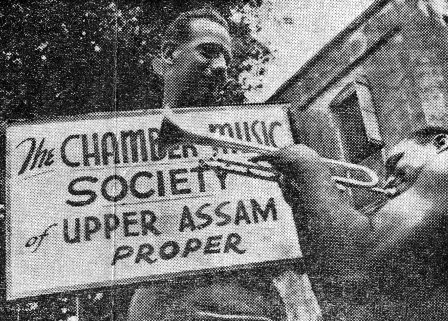 Maj. Melvyn Douglas, former movie actor, now director of the Entertainment Production Unit of the India-Burma
Theater, which produces G.I. shows for G.I.'s seems to be asking himself whether Pvt. Rinehart Parks is another
Harry James. Parks, from New York, is blowing some notes through his trumpet for the EPU show.
Maj. Melvyn Douglas, former movie actor, now director of the Entertainment Production Unit of the India-Burma
Theater, which produces G.I. shows for G.I.'s seems to be asking himself whether Pvt. Rinehart Parks is another
Harry James. Parks, from New York, is blowing some notes through his trumpet for the EPU show.
|
 T/5 Virgil Hammer strums the banjo in the Entertainment Production Unit's headliner, The Show Is On.
This Chanute, Kans., performer has been a popular performer with soldiers in the India-Burma and the China Theaters.
Maj. Douglas declares that big things are ahead for Hammer.
T/5 Virgil Hammer strums the banjo in the Entertainment Production Unit's headliner, The Show Is On.
This Chanute, Kans., performer has been a popular performer with soldiers in the India-Burma and the China Theaters.
Maj. Douglas declares that big things are ahead for Hammer.
|
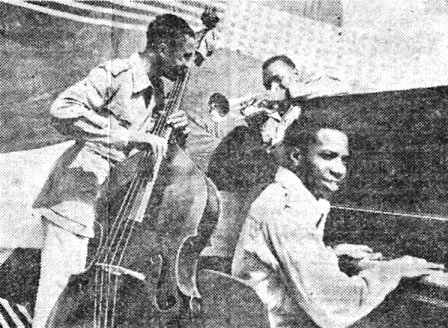 This is a musical trio featured in Entertainment Production Unit's Mr. Jubilee Comes to Town, now
touring the India-Burma Theater. Left to right, Pvt. Nathaniel Hill, Philadelphia, Pa.; Pvt. Rinehart Parks,
Kimball, W. Va.; and Pvt. Warrick Brown, Plainfield, N.J.
This is a musical trio featured in Entertainment Production Unit's Mr. Jubilee Comes to Town, now
touring the India-Burma Theater. Left to right, Pvt. Nathaniel Hill, Philadelphia, Pa.; Pvt. Rinehart Parks,
Kimball, W. Va.; and Pvt. Warrick Brown, Plainfield, N.J.
|
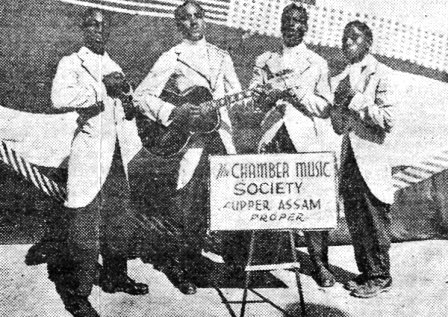 It's the Chamber Music Society of Upper Assam Proper. These boys also are featured in EPU's Mr. Jubilee
Comes to Town. The group includes, left to right, Cpl. Jesse Murrell, Pittsburgh, Pa.; Jacob Milligan,
Lake Wales, Fla.; Pvt. Willie Gullet, Birmingham, Ala.; and S/Sgt. Robert Rucker, Tate, Ga.
It's the Chamber Music Society of Upper Assam Proper. These boys also are featured in EPU's Mr. Jubilee
Comes to Town. The group includes, left to right, Cpl. Jesse Murrell, Pittsburgh, Pa.; Jacob Milligan,
Lake Wales, Fla.; Pvt. Willie Gullet, Birmingham, Ala.; and S/Sgt. Robert Rucker, Tate, Ga.
|

A SOLDIER'S TREASURED GIFT With little time to clasp his new-found wonder, A few short days, and he is on his way As in a dream, the roaring guns throb and thunder. To wound the magic of his wedding day. Yet as he fights he carries in his keeping Faith that will flame even in darkest night Love that will grow when leaden skies are weeping. Honor and pride to gird him for the fight. He will come back to all he is defending - When Victory has brought the world release. A sweetheart's smile to light the long day's ending. And evenings that hold the lovely hush of peace. - CPL. JOSEPH M. FILEPS, APO 218. |
|
REFLECTION Said General No. 1 to General No. 2 "I have a medal here that I will give to you. The only stipulation is that you give one to me. And put it in the Roundup for all the world to see." So he stuck a small fruit salad on the bosom of his buddy And sounds were made to indicate that he'd fought battles bloody. The cameras clicked, the photogs cursed; they knew 'twas not the end; Within a week, a month, a day, they'd do it all again. For hadn't No. 2 said he'd retaliate in Kind. And pin a pin on No. 1 so he'd not be behind? The DFC, the DSC, the Soldier's Medal, too - They all look swell on generals - but how would they look on you? - ANONYMOUS G.I. |
|
(The following effort of a New Orleans Kipling was sent to a soldier in Burma and then mailed to Roundup by
Maj. George W. Williams, Jr. - Editor.) COME YOU BACK, YOU YANKEE SOLDIER By the old St. Lou cathedral Looking out on Jackson Square. There lies a quaint old city That wishes you were there; For the booze is in the glasses And the tinkling cubes they say Come you back, you Yankee soldier, Come you back to U.S.A. Come you back to U.S.A. Where one and all can play. And the dawn comes up like thunder When you arise next day. |
|
Service of Chaplains
In the jungle wastes, mountain outposts and monsoon-drenched land that makes up the forward areas of the India-Burma Theater, Chaplains of every faith are serving alongside the combat men, pipeline crews, road builders, railroad operators, and the men who make the air their kingdom.
They iron out personal problems, act as intermediaries between the enlisted man and the CO, write letters of condolence, visit hospitals, minister to the dying and conduct the last rites.
Nor have these services been without cost to the Chaplain Corps. Two of these Chaplains, both Catholics, lie buried side by side at Ledo, alongside others who participated in the North Burma campaign which culminated in the opening of the Stilwell Road to China.
WITH COMBAT FORCES
Both served with the American combat ground forces in the jungles of Burma. Both died of typhus contracted in the hell of the Burma jungle.
One was Father Thomas J. Barrett of Chicago, who died in June, 1944. The other was Father Ladislaus A. Polewski of Milwaukee, Wis., who passed away in January of this year.
Father Barrett was well known to Maj. Gen. Frank Merrill and his Marauders in their campaign that ended with the capture of Myitkyina. Pfc. Al Hall, one of the Marauder veterans, described Father Barrett as "one who would go anywhere to help anyone, no matter what his faith."
When the Marauders were going into the jungle, Father Barrett volunteered to go with them. Maj. G. A. King, S.J., Catholic Chaplain, who has been in the Theater longer than any other Chaplain, says he believes the name of Father Barrett will long live in the minds and memories of the American soldiers who served in the Burma campaign.
BARRETT'S DEATH
Chaplain King described the passing of Father Barrett as told to him by Chaplain Lewis Meyer, who prepared him for death.
"Father Meyer told me that his last request was that a Mass be said for his men. He described how Father Barrett finally was evacuated from the jungle to a Base Hospital. He said Father Barrett clearly showed he was a very sick man. He was gaunt, unkempt from long days in the jungle, and terribly tired. He didn't last long after reaching the hospital. From Chaplains all over the Theater I have had tributes relayed on from men with whom he worked."
Chaplain King also related how Chaplain Meyer also administered the last rites of the church to Father Polewski. Father Polewski, like Father Barrett, had volunteered for service in the jungle. His men were sent on a mission. Although ill at the time, Father Polewski insisted on accompanying them.
He made a four-day march through the jungle with his soldier companions. He even surrendered his own pack mule to fainting soldiers. Later he and stricken G.I.'s were flown out to the hospital. Their Father Polewski died of typhus, having performed his duty to the end. Chaplain Meyer told the story of the last moments of the two priests just recently to Chaplain King before returning to the States for medical treatment after being injured.
CHAPLAIN HUNT
A third member of the Chaplain Corps also died in service over here. He was Arlie G. Hunt, a Protestant minister from Ashland, Kan. His death followed an operation in an evacuation hospital. He was 51 and had also served in World War I.
Another man of God to give his life out here was Father John Hayes, an Irish priest. He was also well known to men in the forward areas, serving as a Chaplain with the 36th British Division of Maj. Gen. Francis W. Festing. Festing's division was one of the most potent units in the Northern Combat Area Command of Lt. Gen. Dan I. Sultan, I-B Theater commander.
EAC Officers Aid Burma Convent
EAC HQ., INDIA - Recent liberation of Mandalay brought new life, hope and answered prayer to 12 nuns and more than 50 Anglo-Burmese orphans, who had been held prisoners in their own convent for three years by the merciless Japs.
A short while ago, officers of a forward RAF Wing of the Eastern Air Command heard the story of the prison-convent and decided to do something about it. Before they left Mandalay, the officers saw to it that the Sisters and their charges had enough food for weeks to come, plus a reserve fund of almost 750 rupees.
The Convent belongs to the Order of Sisters of St. Joseph of The Apparition, associated with similar orphan schools in Manchester and Liverpool. When the Japs captured Mandalay, the Sisters and children were forbidden to leave the convent, although its buildings had been almost entirely destroyed by bombing.
The Rev. Tim Sweeney, Roman Catholic Padre of the Wing who went to their aid, said, "The Japs not only refused to allow them a single ration of rice, but also made it a serious offense for anybody to attempt to give or sell them food. Despite these threatened penalties however, a few Burmese Christians managed to smuggle in enough food and supplies to keep them alive."
The inspiring thing about it, Father Sweeney said, is that "despite all the Sisters have been through in the past 10 to 20 years they have no wish to give up their work in Burma."
ATC Driver Uses Pole For Trailer To China
KUNMING, CHINA - When a convoy of Autocar Tractor and Trailer Refueling Units arrived at this base from India over the Stilwell Highway, spectators were amazed to see one trailer being towed with the aid of a telegraph pole.
Cpl. Peter Berganciano's unit broke down about 85 miles from Kunming, Berganciano, with true ATC ingenuity, recruited 50 Chinese coolies, had them dig up a telegraph pole and insert it underneath the trailer as an improvised frame. He finished the last 85 miles with the pole arrangement.
The convoy was in the charge of Lt. James D. McGuire, assisted by Sgts. Fletcher R. Reynolds and Woodrow W. Jenkins, Cpl. Houston W. Stone and Pfc. Paul V. Clark.
ASSAM SNIPES WARY OF HUNTMAN'S BAG
1328TH AAF BU, ATC, ASSAM - For whiling away a hot summer night there's nothing like an old-fashioned snipe hunt.
Pfc. Willis Searing was overjoyed when, after much pleading, he was permitted to accompany his buddies, Sgt. major Phillips, Cpl. E. Young and Pfc. Ozzie Walgole, when they went out one recent night to catch
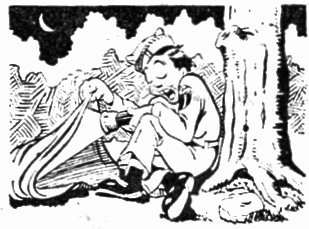
|
Darkness found gullible Searing deep in the jungle, holding open the bag with one hand and clutching the light in the other, his mouth watering in anticipation of a delicious snipe fry. He waited. Hours passed. Still no snipes.
The snipes, decided Searing, just weren't biting tonight. Disappointed, he began the long walk back to his basha. Soon he was met by an officer, who, noticing the bag and light, informed Searing he was under arrest for hunting snipes out of season. Culprit Searing pointed out that he hadn't caught any snipes. Sentence suspended.
When he finally dragged his weary body home, Searing found his fellow hunters howling with laughter over some secret joke, which is the way all good snipe hunts end.
HUNTER TRIO SUPPLY 'BURMA PEACOCKS'
ASC BASE, BURMA - Living in the semi-wilds of Northern Burma has its disadvantages but one of them - thanks to sportsmen in the Signal Company of the Burma Peacock Air Service Group - isn't the lack of fresh meats.
Since November of last year, T/3 Barien E. Teagle of Oklahoma City, Okla., Sgt. Leonard W. Taylor of Durham, N.C., and Pfc. Walter S. Wosz of Chicago, Ill., have, with the occasional assistance of other men, brought into their company approximately 20,000 pounds of fresh meat killed in the surrounding hills and mountains.
|
CLIMAX LONG AIR WAR
HQ., EASTERN AIR COMMAND - Bombers, fighters and transports of Maj. Gen. George E. Stratemeyer's Eastern Air Command this week brought the Burma aerial campaign to a crashing climax as they backed up the British 14th Army in its capture of Rangoon.
Heavy monsoon clouds and bumpy flying weather failed to hold back Seventh Bomb Group and RAF Liberators, 12th Bomb Group B-25's and a varied assortment of fighters which pounded the Rangoon area in preparation for the final assault of paratroopers, seaborne forces, and ground units.
A radar installation was destroyed, wireless stations knocked out, and gun positions flattened in attacks on the beachhead area.
HIT AIRDROMES
B-24's, RAF Thunderbolts, Air Commando Mustangs and P-38's of the 459th Fighter Squadron swept four Jap-held airfields, at Moulmein, and at Koke Katheim, Nakorn Sawan and Ban Takli in Thailand, destroying five enemy planes and damaging two, the last vestiges of Jap air power on the Burma front.
On D-Day at Rangoon, C-46's of the Combat Cargo Task Force dropped paratroopers, and shortly after, the Strategic Air Force turned all its power on Elephant Point, at the mouth of the river 20 miles from the city. VCP operators dropped with the skytroops directed Thunderbolts, Mosquitoes, and Beaufighters which strafed the beaches for the seaborne landings. Heavies and mediums had hit the same area earlier, at D-Day's dawn.
AIR SUPPLY
Aerial supply, also, was in at the finish. RAF transports dropping water and ammunition to paratroopers in their longest mission in this Theater. Other RAF Liberators showered medical supplies to Allied prisoners-of-war
|
The Rangoon operation marked the end of three years of Allied aerial harassing of Jap-occupied Burma. USAAF and RAF aircraft, concentrating their blows on communications lines, have been out day and night, week after week, knocking out rail and road bridges, striking locomotives and rolling stock concentrations, burning up motor vehicles on the highways and sinking supply craft on the rivers.
Every freighter sunk in the Gulf of Martaban, every bridge blown out on the railroad from Myitkyina south to Pegu, every truck shot up on the roads of Burma in that period was a milestone in the long road back that came to an end this week in Rangoon.
14TH AIR FORCE HITS NIPS
ON LONING FRONT
HQ., 14TH AIR FORCE - In a week of steadily mounting attacks, 14th Air Force planes continued to punch at Japanese positions in the Han and Tan River Valleys north of Laohokow and on the Loning front in Hunan, in addition to strikes on enemy-used railroads in the Yellow River district.
Despite bad weather in some areas, the 14th's commanders sent out 30 missions one day early in the week, increasing the tempo to 65 missions at week's end. Fighters destroyed or damaged 42 locomotives, sank two rivercraft and damaged eight, and killed hundreds of Jap troops.
Meanwhile, Chinese military spokesman said that battle-tried reinforcements, equipped with modern American weapons, had been flown in to the battle area near the threatened 14th air base at Chihkiang, and stopped the Jap thrust after killing 3,000 of the enemy.
Chihkiang is 250 miles southeast of Chungking.
|
To most of us sweltering soldiery out here, the essential facts of life in India-Burma are an old familiar story, often repeated. But to our next of kin and our erstwhile friends and neighbors on the Home Front, the Orient still has a mysterious and shadowy form as constantly evidenced by remarks in the U.S. Press which betray certain fundamental misconceptions of Asiatic geography and customs.
Just when we had begun to feel that the American people were pretty well oriented on the quiescent "life-line to China" Theater, the New York World Telegram published a mighty interview with Miss "Liz" Tilton, a lovely singer of lively songs, who reported on her overseas tour to the effect that troops were not antagonistic to Hollywood performers, as had been indicated by the remarks of the Army newspaper in that area (guess who?). There was, unfortunately, one flaw in this thesis - Miss Tilton had been in the South Pacific with Jack Benny's USO troupe, and had not come within a good many lengthy stone's throws of the circulation territory of the Roundup, that harrier of hapless Hollywooders.
Many persons other than the incomparable "Liz" have betrayed a lack of map study: one lad who dutifully informed his doting parents that he was located "in Assam," received a puzzled query in reply. The folks wanted to know, "What are Assam? We never heard of them."
DROP AROUND
A Delhi-ite who made the long voyage home on that G.I. 45-day visa was discussing a mutual acquaintance with a friend at home. "Buddy's in Assam," said the friend. "Why don't you run down his way some night and look him up?"
Or the anecdote of a naval officer in our beloved "Little Washington" who goggled at a note from the citadel on the Potomac itself, asking him to drop off a certain package at the Bombay office, "some afternoon."
Folks seem to think the Karachi boys pedal out to the Taj Mahal for an afternoon on their bicycles, or that Assam is located somewhere in the Calcutta suburbs, at the end of the Chowringhee carline.
LITTLE THEATER
Any India-Burma'er who has been home encounters that "potage stamp size" concept of his overseas stomping grounds. He is constantly beset by bright-eyed and well-meaning people, who, on hearing of his station say, "Oh, my nephew Charlie is in India, a tall, dark-haired boy with brown eyes. Have you run across him?"
The blas New Yorker even fumbled one I-B item, identifying dhobis as "general servants," rather than the wash-and-wrench laundrymen who make Army clothing salvage a big-time business out here. Time magazine ran a picture of what it called "ayaks lined up for inspection with their WAC mistresses in Calcutta." The bearers and assorted other help who brighten our corners in these regions have trouble enough getting sahib and memsahib and their gear in shape for formal presentation, without falling out personally for the critical eye of the inspecting officer.
'GET WALLAH'
Old India hands were understandably puzzled by one reference in the article by the United Press's Harrison Salisbury, who praised the adaptability and "know how" American troops had shown in all their worldwide stations. "Americans have learned," he wrote, "How to get a wallah in Calcutta," which is a pretty negligible talent as we see it. A "wallah" is "one who" or "that which" does anything, the word being used, of course, in conjunction with another noun to cover every field of human endeavor from pulling rickshaws to joining political parties.
And lastly, Eddie Cantor, writing in Variety of his "Purple Heart Circuit" in the States, entertaining wounded servicemen in hospitals, told feelingly how he had mentally toured all the fronts, seeing the overseas picture with his mind's eye through conversations with the injured veterans. "I have sailed the seas on a destroyer; I have lain in a Normandy foxhole," was the gist of his words, then "I have walked the Ledo Road with a Marine." Better look at that street sign again, Eddie. You're in the wrong town.
The Roundup is a weekly newspaper of the United States Forces, published by and for the men in Burma and India, from news and pictures supplied by staff members, soldier correspondents, Army News Service and United Press. The Roundup is published Thursday of each week and is printed by The Statesman in New Delhi and Calcutta, India. Editorial matter should be sent directly to Capt. Floyd Walter, Hq., S.O.S., I.B.T., APO 885, New York, N.Y., and should arrive not later than Saturday in order to make that week's issue. Pictures must arrive by Friday and must be negatives or enlargements. Stories should contain full name and organization of sender. Complaints about circulation should be sent directly to Lt. Sidney R. Rose, Hq., S.O.S., I.B.T., APO 885, New York, N.Y. Units on the mailing list should make notification of any major change in personnel strength or any change of APO.

MAY 10, 1945
Adapted from the original issue of India-Burma Theater Roundup
Copyright © 2007 Carl Warren Weidenburner
TOP OF PAGE PRINT THIS PAGE ABOUT THIS PAGE SEND COMMENTS
PREVIOUS ISSUE CLOSE THIS WINDOW NEXT ISSUE
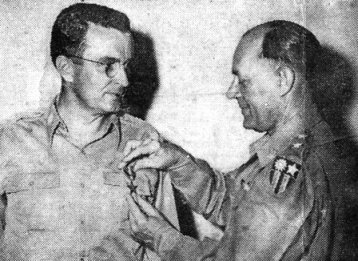 Maj. Gen. W. E. R. "Billy" Covell, head of Services of Supply in the India-Burma Theater, pins the Bronze Star on Lt. Col. Henry G. Gerdes for "exceptionally meritorious service" on the pipeline to China.
Maj. Gen. W. E. R. "Billy" Covell, head of Services of Supply in the India-Burma Theater, pins the Bronze Star on Lt. Col. Henry G. Gerdes for "exceptionally meritorious service" on the pipeline to China.
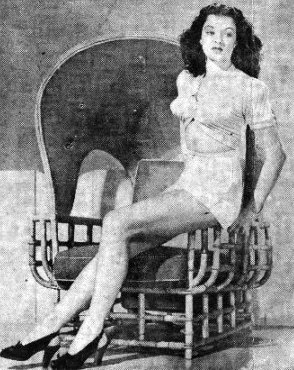 T/3 Sterling Bemis spends part of his time collecting historical facts of the India-Burma Theater and another part of his time collecting other historical data like the above. It is Karen Randall, Universal Pictures starlet, and we must admit she wouldn't have helped any in putting out the great Chicago fire.
T/3 Sterling Bemis spends part of his time collecting historical facts of the India-Burma Theater and another part of his time collecting other historical data like the above. It is Karen Randall, Universal Pictures starlet, and we must admit she wouldn't have helped any in putting out the great Chicago fire.
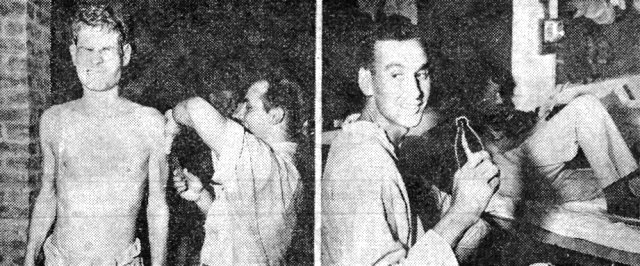 Here are two Americans rescued by the 14th Army near Pegu after having been POWs in the hands of the Japanese.
At left, Lt. Allan D. DuBose, of San Antonio, Tex., finds it's the same old Army as he "smilingly" absorbs a shot from Sgt. Orlando Roberto of the 142nd General Hospital in Calcutta. After 18 months as a prisoner in Rangoon, DuBose finds that times change, but not the Army. And at right, Maj. Wesley Werner of St. Louis, happily quaffs his first bottle of beer at the same hospital in Calcutta. Werner had been a prisoner of the Nips since November 17, 1942. A former pilot with the old Seventh Bomb Group he is remembered by old timers in the Theater as the skipper of the noted B-24 Rangoon Rambler. Werner was one of the best known airmen in the 10th Air Force.
Here are two Americans rescued by the 14th Army near Pegu after having been POWs in the hands of the Japanese.
At left, Lt. Allan D. DuBose, of San Antonio, Tex., finds it's the same old Army as he "smilingly" absorbs a shot from Sgt. Orlando Roberto of the 142nd General Hospital in Calcutta. After 18 months as a prisoner in Rangoon, DuBose finds that times change, but not the Army. And at right, Maj. Wesley Werner of St. Louis, happily quaffs his first bottle of beer at the same hospital in Calcutta. Werner had been a prisoner of the Nips since November 17, 1942. A former pilot with the old Seventh Bomb Group he is remembered by old timers in the Theater as the skipper of the noted B-24 Rangoon Rambler. Werner was one of the best known airmen in the 10th Air Force.
 Tons of bombs cascade from a B-29 Superfortress of Brig. Gen. Roger M. Ramey's XX Bomber Command in a recent raid near Rangoon.
Tons of bombs cascade from a B-29 Superfortress of Brig. Gen. Roger M. Ramey's XX Bomber Command in a recent raid near Rangoon.
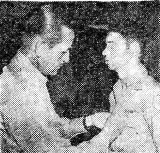 Lt. Jack Hull, XX Bomber Command bombardier, has the DSC pinned on by his Commanding General, Brig. Gen. Roger M. Ramey. Hull was wounded in the left eye and right arm over Singapore by ack-ack. Despite his wounds, he dropped his bombs.
Lt. Jack Hull, XX Bomber Command bombardier, has the DSC pinned on by his Commanding General, Brig. Gen. Roger M. Ramey. Hull was wounded in the left eye and right arm over Singapore by ack-ack. Despite his wounds, he dropped his bombs.
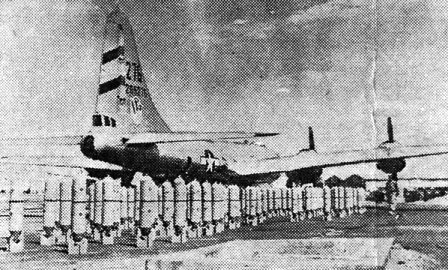 Incendiary bombs are loaded into the bomb bay of a B-29 at an Indian base of the XX Bomber Command. The plane is being readied for a strike against Kuala Lumpur on the Malay Peninsula.
Incendiary bombs are loaded into the bomb bay of a B-29 at an Indian base of the XX Bomber Command. The plane is being readied for a strike against Kuala Lumpur on the Malay Peninsula.
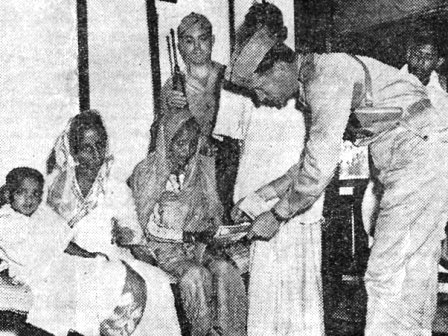 As Capt. Stephen Lane, witnessing officer, stands by, Capt. Joseph Mazey,
Finance Officer, redeems accumulated
dependency allotment checks totaling Rs. 800 to the wife, child and mother of Miha Mossaddar, an Indian who is
now a Stateside G.I.
As Capt. Stephen Lane, witnessing officer, stands by, Capt. Joseph Mazey,
Finance Officer, redeems accumulated
dependency allotment checks totaling Rs. 800 to the wife, child and mother of Miha Mossaddar, an Indian who is
now a Stateside G.I.
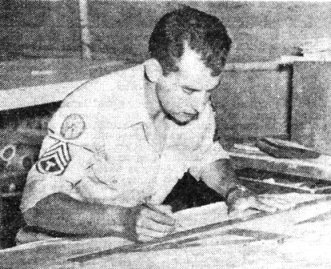
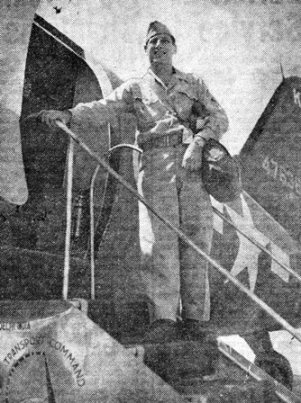 M/Sgt. Fred Friendly, Information and Education wallah in the India-Burma Theater, boards an Air Transport
Command plane for his first hop toward the European Theater of Operations. He will tell us all about it when he
gets back.
M/Sgt. Fred Friendly, Information and Education wallah in the India-Burma Theater, boards an Air Transport
Command plane for his first hop toward the European Theater of Operations. He will tell us all about it when he
gets back.
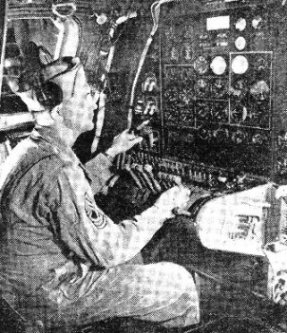 First photograph of the flight engineer of a B-29 Super-Fort at his complicated control board, which relieves
the pilot and co-pilot of engine control and basic mechanical system operations. The engineer is behind the co-pilot
and faces towards the plane's rear.
First photograph of the flight engineer of a B-29 Super-Fort at his complicated control board, which relieves
the pilot and co-pilot of engine control and basic mechanical system operations. The engineer is behind the co-pilot
and faces towards the plane's rear.
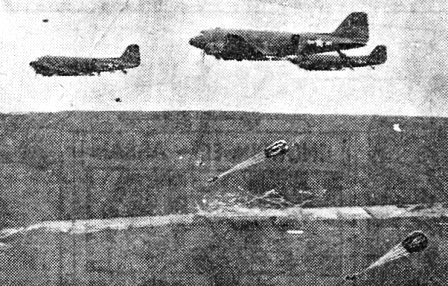 Cutes of three Indian paratroops open up over their dropping zone in part of the operation which took Rangoon.
Parapacks, containing equipment and supplies, needed by the paratroopers, are carried like bombs under the bellies
of the planes. These are dropped when the men have cleared.
Cutes of three Indian paratroops open up over their dropping zone in part of the operation which took Rangoon.
Parapacks, containing equipment and supplies, needed by the paratroopers, are carried like bombs under the bellies
of the planes. These are dropped when the men have cleared.
